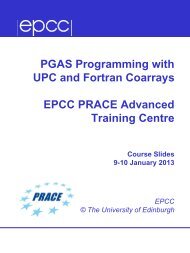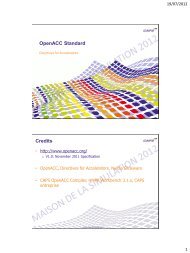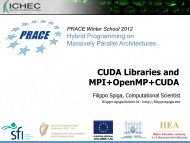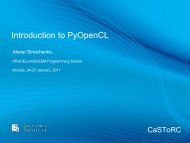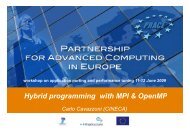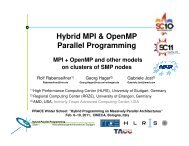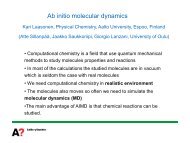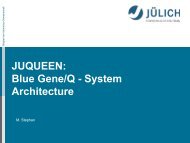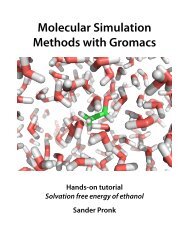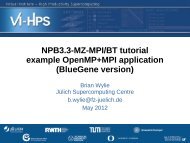Large scale and hybrid computing with CP2K - Prace Training Portal
Large scale and hybrid computing with CP2K - Prace Training Portal
Large scale and hybrid computing with CP2K - Prace Training Portal
Create successful ePaper yourself
Turn your PDF publications into a flip-book with our unique Google optimized e-Paper software.
<strong>Large</strong> <strong>scale</strong> <strong>and</strong> <strong>hybrid</strong> <strong>computing</strong> <strong>with</strong> <strong>CP2K</strong>Joost V<strong>and</strong>eVondeleNano<strong>scale</strong> Simulations, ETH Zurich
Sustainable energy productionA gr<strong>and</strong> challenge for society which willrequire novel materials engineered <strong>with</strong>atomistic precisionGrätzel, Nature (1991,2001)Novel simulation tools can contribute towardsrational design of complex systems
Modeling complex systemsDensity functional theory (DFT) & computational methods(1998, Nobel Prize, Walter Kohn- John A. Pople)A computationally tractable reference system of non-interacting particlescan be used to obtain all properties (in particular the density <strong>and</strong> energy) ofa true electronic system. The required external potential (Vxc) exists but isonly known approximately.
Modeling complex systemsEmpirical modelsSIZE<strong>scale</strong>Multi-<strong>scale</strong>~100'000 atoms~1-1000 ns© nobelprize.org (1998)Enhanced samplingTIME~10 atomsstatic~1'000 atoms~1-100 psReduced dimensionalityAll time<strong>scale</strong>s
What is <strong>CP2K</strong> ?<strong>CP2K</strong> is a freely available program to perform atomistic<strong>and</strong> molecular simulations of solid state, liquid, molecular<strong>and</strong> biological systems. It provides a general frameworkfor different methods such as e.g. density functionaltheory (DFT) [...]On our web page since the initial version in 2004-10-16
Gaussian <strong>and</strong> plane waves:GPW in <strong>CP2K</strong>•Primary basis: Gaussians- compact- sparse H ks (<strong>and</strong> P)- Many terms analytic•Auxiliary basis: Plane waves- regular grid for e - density- FFT for Poisson equation- No four center integrals neededChemistryPhysicsThe GPW algorithm : compute the GGA Kohn-Sham matrixin O(N) time, PBC are natural.J. V<strong>and</strong>eVondele, M. Krack, F. Mohamed, M. Parrinello, T. Chassaing <strong>and</strong> J. Hutter, Comp. Phys. Comm. 167, 103 (2005).Lippert, G; Hutter, J; Parrinello, M. Mol. Phys., 92 (3), 477-487 (1997).
<strong>CP2K</strong>: the swiss army knife ofmolecular simulation● A wide variety of models Hamiltonians● classical● semi-empirical● local <strong>and</strong> non-local DFT● Combinations (e.g. QM/MM)● Various algorithms● Molecular dynamics & Monte Carlo● NVE, NVT, NPT● Free energy <strong>and</strong> PES tools● Ehrenfest MD● Properties● Vibrational● NMR, EPR, XAS, TDDFT● Open source & rapid development● 900.000 lines of code
<strong>CP2K</strong>: the swiss army knife ofmolecular simulation● A wide variety of models Hamiltonians● classical● semi-empirical● local <strong>and</strong> non-local DFT● Combinations (e.g. QM/MM)● Various algorithms● Molecular dynamics & Monte Carlo● NVE, NVT, NPT● Free energy <strong>and</strong> PES tools● Ehrenfest MD● Properties● Vibrational● NMR, EPR, XAS, TDDFT● Open source & rapid development● 700.000 lines of code
What is <strong>CP2K</strong>: teamWith contributions from: Axel KohlmeyerBarbara Kirchner Ben Slater ChrisMundy Fawzi Mohamed FlorianSchiffmann Gerald Lippert GloriaTabacchi Greg Schenter Harald ForbertIain Bethune William Kuo Ken BagchiSundaram Balasubramanian JochenSchmidt Jens Thar Jürg Hutter MatthiasKrack Matt Watkins Marcella IannuzziManuel Guidon Matthew McGrathThomas Chassaing Thomas HeineThomas Kuehne Teodoro Laino UrbanBorstnik Joost V<strong>and</strong>eVondele BenjaminLevine Luca Bellucci Ari Seitsonen LouisV<strong>and</strong>uyfhuys Mathieu Salanne MicheleCeriotti Lukasz Walewski MichaelSteinlechner Rodolphe VuilleumierSebastiano Caravati Valery Weber KevinStratford Toon Verstraelen Marcel BaerAless<strong>and</strong>ro Laio Stefan Goedecker LuigiGenovese Thierry Deutsch Dieter GleichReinout Declerck Kurt Baarman MauroDelBen M<strong>and</strong>es Schönherr Yannik MisteliFabio Sterpone Gerd Berghold PietroBallone Walter Silvestri Pekka ManninenFrancois-Xavier Coudert ChristianePousa Michele Parrinello Michiel SprikIlja Siepmann Michel WaroquierTen years of development at 200 lines / day = O(1M) SLOC, <strong>with</strong> a large base of contributors
How do we collaborate ?● SVN● Email● Meet & TalkAn animated view of SVN history
<strong>CP2K</strong>: science (I)Electronic structure of nanoparticles
<strong>CP2K</strong>: science (II)Disordered <strong>and</strong> frustrated materials
<strong>CP2K</strong>: science (III)Structure prediction of metal organic frameworks
<strong>CP2K</strong>: science (IV)Functionalized solid/liquid interfaces
<strong>CP2K</strong>: algorithmsThe power & challenge of <strong>CP2K</strong>:a wide range of algorithms<strong>with</strong> good scaling properties● Regular grids: halo-exchange, 3D FFT, Poisson solver, multigrids● Dense Linear Algebra: Multiply, Diagonalization, Cholesky,...● Sparse Linear Algebra: Matrix Multiply● Particles: time integration, Monte Carlo sampling● Chemical: 4 center integrals, HFX, MP2, XC, ...A single kernel rarely dominatesScaling is O(N)...O(N**5)a) Depending on method <strong>and</strong> system size various kernels will dominateb) Depending on the dominating kernel, particular hardware might be suitablec) If several kernels dominate optimization is more of a challenge
Modern Compute Resourcesfor atomistic simulationPerform calculations that+/- complete faster- AIMD: at the limit of strong scaling (network)+ Ensemble simulations: connect to experiment+ are cheaper+ are technically better converged (grids, basis, sampling)+ are based on more accurate theory+ are based on larger models
<strong>CP2K</strong> on CSCSproduction hardwareFor a typical user benchmark, the per node (~ per Watt) performancehas improved significantly.
<strong>CP2K</strong> on CSCSproduction hardwarePer core, we can fight the clock-frequency trend....XE6 in the above graph is 32 cores per node.
Complex hardware:NUMA nodes <strong>with</strong> PCI devicesNUMA Within SocketPCI devices (network / GPU)socketMPPMcorecorecorecoreMPPMcorecorecorecorecorecorecorecoreMPPMMCMCMemoryMemoryMPPMPCIPCIShould we leave thread placement,Task placement <strong>and</strong> memory management to the system ?GPUGPU
Complex hardware:Network topology3D Torus on the XK6'Nearest neighbor commson a 2D grid'Need to think aboutprocess layout or weneed better networks.
More accurate theory:From 'GGA' to 'HFX' to 'MP2'
Exchange & correlation functionalsExchange <strong>and</strong> correlation functionals of improving canbe constructed by adding new ingredients.Each rung on the ladder improves accuracy, but alsoincreases complexity1) GGA: only relies on the electron density <strong>and</strong> itsgradients (semi-local)2) Hyper-GGA: <strong>hybrid</strong> functionals, includes density<strong>and</strong> the single particle orbitals directly in a non-localway through Hartree-Fock exchange (HFX)3) Double <strong>hybrid</strong>s: include some MP2-like termsMundy, Kathmann, Rousseau, Schenter,V<strong>and</strong>eVondele, Hutter, SCIDAC reviews (spring 2010).
Hartree-Fock exchangeAn easy term in Gaussian basis sets, but brute force scaling as O(N 4 )2'825 atoms→31'247 basis functions→976'375'009 elements in P→ 953'308'158'199'750'081 integralsExa-Pet-Ter-Gig-Meg-KilDo we need exa-<strong>scale</strong> <strong>computing</strong>, or can we be scientist ?
O(N 4 ) → O(N)Based on the fact that for large systems either the integralsOr the density matrix become zero (to <strong>with</strong>in a threshold eps)Cauchy-Schwarz screeningO(N 2 )Density matrix screening P decays exponentially O(N)Operator screening Operators other than 1/rO(N)
O(N) HFX: measurementsLinear scaling is key .... thous<strong>and</strong>s of molecules possibleOn 'st<strong>and</strong>ard' cluster hardware in minutes.
Parallel implementation: OMP/MPIE=v T (Mv) ?Distribute the matrix M (dim: 10 9 x 10 9 ), replicate the vector vSimple communication pattern (v is distributed in GGA mode)allows for exploiting the full symmetries (8x speedup)Advanced load balancing model usedv <strong>and</strong> (Mv) can be rather large vectors (10 9 elements)Exploit current architectures (e.g. 16 cores <strong>with</strong> 16Gb per node) → MPI/OpenMPShared v <strong>and</strong> (Mv), v is read-only, (Mv) is atomically updatedExploit that only O(N) entries of v are non-zero → sparse storage for vRemaining memory used for storing M.
Many-core era: OMP/MPIMain benefits:➔ Increase memory per MPI task➔ Extend the scalability plateau➔ Access >10000s of cores➔ Interface to GPU (XK6)➔ Speedups for some parts of the codeMain issues:➔ Loop level OMP is not sufficient➔ Analyzing OMP performance difficult➔ Non-deterministic threading bugs➔ Libraries (scalapack) poorly threaded➔ Compilers & toolsRosa XE6 dataHere computer centers can help! EPCC (EPSRC/PRACE funded) did so.
Parallel efficiencyHFX remains computationally much more dem<strong>and</strong>ing than GGA DFT (10x?)A good parallel implementation is m<strong>and</strong>atoryFull code10 steps of MD, 64 H 2O, 2560 BF,OpenMP: 8 threads/nodeHFX code out-<strong>scale</strong>s theRemaining (GGA) part of <strong>CP2K</strong>HFXProvided enough compute power,Hybrid simulations run essentiallyas fast as GGA(9s / BOMD step @ 4096 cores)
In-core integral compressionAlmost all simulations are performed using an in-core algorithm→ 10x speedup is observed.Highly efficient scheme: index free <strong>and</strong> lossy compressionGuidon, M; Schiffmann, F; Hutter, J; V<strong>and</strong>eVondele, J. 2008 ; JCP 128(21): 214104
Paier J; Diaconu CV; Scuseria GE; Guidon M; V<strong>and</strong>eVondele J;Hutter J. 2009: PRB 80(17): 174114Guidon M; Hutter J; V<strong>and</strong>eVondele J. 2009: JCTC 5(11): 3010-3021LiH: Parallel efficiency &in-core operationInitial speed:Using CPU efficientlySuperlinear speedups:Using all memoryGood <strong>scale</strong>-out:Using network
Auxiliary Density Matrix Methods(ADMM)For certain density matrices HFX can be computed very efficiently(e.g. small basis sets or increased sparsity)Transform an expensive matrix into a cheap one,use a GGA for estimating the differenceOne example: wavefunction fitting, using an auxiliary basisGuidon M; Hutter J; V<strong>and</strong>eVondele J; JCTC 6(8): 2348-2364
ADMM: performanceSt<strong>and</strong>ard <strong>hybrid</strong>ADMM based <strong>hybrid</strong>The DFT model: a solvated proteinA fully solvated protein computed <strong>with</strong>in minutes using <strong>hybrid</strong> functionalsComputer science must be combined <strong>with</strong> domain knowledge!Guidon M; Hutter J; V<strong>and</strong>eVondele J; JCTC 6(8): 2348-2364
Møller-Plesset Perturbation TheoryThe energy:Two electron integrals over canonical molecular orbitals (MO):The four index transformation, going from AO to MOMP2 is relatively expensive O(N 5 ), not easy to parallelize efficiently,<strong>and</strong> somewhat tricky in the condensed phase for an AO code.
GPW-MP2A Gaussian <strong>and</strong> plane waves approach to MP2Directly obtain half transformed integrals using the GPW approach:Leads to a highly efficient parallel implementation.Del Ben M, Hutter J, V<strong>and</strong>eVondele J: to be submitted
Parallel efficiencyCO 2crystal (32 molecules)cc-QZVP basis (5184 BF)Canonical GPW-MP2 calculationMP2 time: 9min.parallel efficiency: 80%On 102400 cores
<strong>Large</strong>r model systems
Linear Scaling SCF<strong>Large</strong>st O(N 3 ) calculation <strong>with</strong> <strong>CP2K</strong>(~6000 atoms)Traditional approaches to solve the selfconsistentfield (SCF) equations are O(N 3 )limiting system size significantly.A newly implemented algorithm is O(N),allowing for far larger systems to be studied.4nm22nm22nm22nm<strong>Large</strong>st O(N) calculation <strong>with</strong> <strong>CP2K</strong>(~1'000'000 atoms)
Linear Scaling SCFNew regime: small devices, heterostructures,interfaces, nano-particles, a small virus.Gate-all-around FETSolvated STMV: 1MWith Mathieu Luisier1.5M atomsAnatase nanocrystalCaplovicova et al.App. Cat. B, 224, 117
Sign matrix iterationsThe density matrix (P) is function of HA simple iterative scheme (Newton-Schultz) gives sign(A):Using only sparse matrix matrix multiplies (not SPMV!)linear scaling can be obtainedA dedicated sparse matrix multiply library is extremely importantThis library is being ported to GPUs
Millions of atomsin the condensed phaseAccurate basis sets, DFT46656 coresThe electronic structureO(10 6 ) atoms in < 2 hoursMinimal basis sets:DFT, NDDO, DFTB9216 coresBulk liquid water. Dashed lines represent ideal linear scaling.V<strong>and</strong>eVondele, Borstnik, Hutter, JCTC
Towards O(1) :constant walltime <strong>with</strong> proportional resourcesTotal timeStringent test:Small blocks, large overheadVery sparse matricesRunning <strong>with</strong> 200 atoms / MPI taskOverheadLocal multipliesCommunicationLocal multiplies constant (OK!).Overhead & CommunicationGrows <strong>with</strong> sqrt(N)Needs a replacement for CannonWork is underway to replace the Cannon algorithm <strong>with</strong> something new!Retain the sqrt(N) max comm, yield constant comm in the limit.
DBCSR: a sparse matrix libraryDistributed Blocked Compressed Sparse RowDistributed Blocked Cannon Sparse RecursiveTarget the application: atoms → Blocks (e.g. 5x5, 13x13, 23x23)Linear scaling → SparseFully dense → Cannon<strong>Large</strong> <strong>scale</strong> → DistributedHigh Performance → RecursiveCannon style communicationon a homogenized matrix forstrong scaling
The local multiplicationA two stage process:● Index building: figure out what to calculateA cache-oblivious● Computation: Do the calculations recursive approachLIBSMM: an autotunedCPU library for small matrixmultiplication: 2x faster thanoptimized blas for applications
An auto-tunedsmall matrix muliply libraryC=C+A x BLibsmm outperforms optimized blas : 2x-10x● Various 'strange' sizes needed●5x5, 5x13, 13x13 ...● H<strong>and</strong>-optimization● too difficult● too time-consuming● not-flexible enough (new chips)● Auto-generate a separate library● Easy● Fast● Flexible● Now availableAutogeneration – Autotuning … a powerful approach to performance (Atlas, FFTW, ...)
GPU Kernel DescriptionCompute a batch Cij, Aik, Bkj of small matrix block products (5x5 .. 23x23)Not too different from batched dgemm (Ci=Ci+Ai*Bi) available in cudablas 4.1CUBLAS Batched dgemm reachesOnly ~50 Gflops for 23x23Need to:1) exploit dependencies(data reuse)2) Better compute kernelSort batch on Cij so we have only 2 data read/writes instead of 4.H<strong>and</strong>-optimize a CUDA kernel for size 23x23 (playing <strong>with</strong> registers / occupation etc)
The GPU port of DBCSR (I)Not so easy … ran into many issues <strong>with</strong> tools… but received excellent support from Cray/NVIDIA/<strong>CP2K</strong> team● Up to 3x performance slowdown in MPI for dynamically linked binaries● Fix: use a (not yet released) Cray patched libudreg.so.0 (?)● ran into CCE miscompilation● Fix : compile selected file at -O0● problems <strong>with</strong> (virtual) memory management● Fix: use hugepages● A <strong>CP2K</strong> bug● Fix: add a memcpy.● Up to 10X threading performance difference between compilers● Investigating (not crucial for final benchmark)● Cuda-memcheck crashes/gave false positives● Ignore after checking carefully● Usual tools (valgrind or <strong>CP2K</strong> internal timing/memory trace) do not work● acceptNot a particularly time efficient procedure...Not for every developer …Not <strong>with</strong>out excellent support ….
The GPU port of DBCSR (II)Open Challenges:● Only one process per node can connect to GPU.Need a functional OMPed code as well● Work sharing between GPU <strong>and</strong> CPU not yet optimal.Have the CPU also do stacks of multiplications ?● Sending data panels to GPU not yet overlapping <strong>with</strong> any workCould be started as soon as MPI completes. Maybe double buffering● GPU Kernel optimized for 23x23 matrices (water molecule). We need many sizes.Needs an auto-tuning <strong>and</strong> auto-generating framework for the GPUA strategy to deal <strong>with</strong> smaller blocks.
GPU multiplication benchmarkBenchmark matrix-matrix multiplication <strong>with</strong> r<strong>and</strong>om [0..1]matrix, quasi-realistic fill-in patternHybrid MPI+OpenMP+CUDA Fortran/C codeNREP=6: Matrix dimension N=159’000;50% occupation
GPU application benchmark●>400 multiplications for 1 run.●Additional thresholding in multiplications (less flops for same data)●This week's results.... subject to change20736 atoms (6912 water molecules), matrix dim 159000, on 576 nodes XK6,~60 matrix multiplications / iter.XK6 <strong>with</strong>out GPU : 1965s per iterationXK6 <strong>with</strong> GPU : 924s per iterationSpeedup 2.12xMPI performance (b<strong>and</strong>width) appears to be the bottleneck (e.g. 50% slowdown<strong>with</strong>out custom rank reordering) :● Still need to figure out MPI performance (incl. effectiveness of overlap).● Is the dynamic linking still an issue ?● Any interference between GPU+CPU ?● One Communication thread per node enough ?
Further thoughts <strong>and</strong> conclusionsComputational atomistic modeling is a lot of fun!A wide range of algorithms is important for DFT simulationsImplementation, algorithm <strong>and</strong> theory all have their role to playGood theories <strong>and</strong> algorithms require knowledge of the scientific problem being solvedUnderst<strong>and</strong>ing the hardware is important, but challenging given the rapidly changing fieldHierarchical parallelism will be needed to <strong>scale</strong> to 1000s of nodes.GPU/MIC/etc. coding is still challenging, will improve as a wider range of software is ported<strong>Large</strong> scientific codes will increasingly benefit from new development methodologies.The Fortran/MPI combo is still the level you can expect in academia
AcknowledgementsZürichJuerg HutterUrban BorstnikChristian PousaMauro Del BenManuel GuidonValery WeberWorld-wide<strong>CP2K</strong> TeamPNL&MinnesotaChris MundyCSCS&EPCC&CRAY&NVIDIAIain BethuneNeil StringfellowPeter MessmerJohn LevesqueRoberto AnsaloniYou for your attention!Flops&MoreCSCSORNLUZHETHSNFINCITEEU-FPDEISAPRACE



